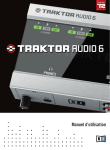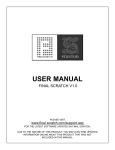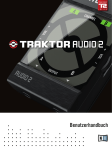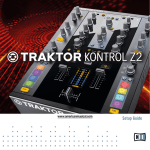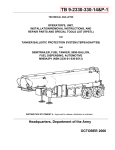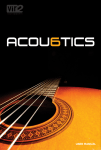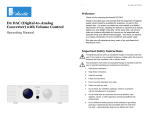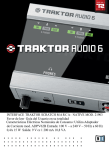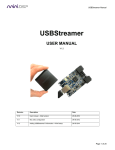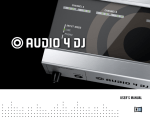Download Traktor Audio 2 Manual English
Transcript
Manual ENGLISH TRAKTOR AUDIO 2 Manual Table Of Contents 1 Welcome to TRAKTOR AUDIO 2!.......................................................................................... 4 1.1 What is Included in the Box?........................................................ 4 1.2 Manual Conventions.................................................................... 4 2 Safety Precautions............................................................................................................. 6 2.1 Risk of Damaging your Hearing..................................................... 6 2.2 Caution...................................................................................... 6 2.3 Notice........................................................................................ 7 2.3.1 Disposal of the Product....................................................... 7 2.3.2 Specifications Subject to Change.......................................... 7 2.3.3Disclaimer.......................................................................... 7 3Installation.......................................................................................................................... 8 3.1 System Requirements.................................................................. 8 3.2 Software Installation................................................................... 8 3.2.1 Installing TRAKTOR AUDIO 2 on Windows 7......................... 8 3.2.2 Installing TRAKTOR AUDIO 2 on Windows XP/Vista.............. 11 3.2.3 Installing TRAKTOR AUDIO 2 on Mac OS X.......................... 14 3.3 Connecting the Hardware............................................................ 18 3.4 Registration............................................................................... 19 4 Basic Configuration..........................................................................................................20 4.1 Selecting the TRAKTOR AUDIO 2 as Your System's Default Audio Output Device............................................................................20 4.1.1 Windows XP......................................................................20 4.1.2 Windows Vista, Windows 7..................................................20 4.1.3 Mac OS X..........................................................................21 4.2 Using the TRAKTOR AUDIO 2 as an Audio Output Device with Music Software..........................................................................21 5 The Hardware in Detail.....................................................................................................22 6 Advanced Configuration...................................................................................................25 6.1 Advanced Configuration on Windows (Control Panel)......................25 6.1.1 Audio Settings Page...........................................................26 6.1.2 Diagnostics Page...............................................................29 6.2 Advanced Configuration on Mac OS X..........................................32 Using the TRAKTOR AUDIO 2.............................................................................................34 8 Troubleshooting................................................................................................................35 8.1 Solving Hardware-related Problems..............................................35 8.2 How to Check Whether the TRAKTOR AUDIO 2 Drivers are Installed Correctly......................................................36 8.3 USB Troubleshooting..................................................................37 8.3.1 USB 2.0 required...............................................................37 8.3.2 Try another USB cable........................................................37 8.3.3 Using a powered USB 2.0 hub............................................37 8.3.4 Recommended USB-ports (MacBook Only)...........................37 8.3.5 Disable USB Energy Saving Mode (Windows only).................38 8.3.6 Update the Driver..............................................................38 8.4 Physically Re-configuring the TRAKTOR AUDIO 2.........................38 8.5 Check your IRQs (Windows only)..................................................38 9 Getting Help......................................................................................................................39 9.1 Readme / Knowledge Base / Technical Support.............................39 9.2 Forum.......................................................................................40 9.3 Updates....................................................................................40 10 Appendix........................................................................................................................... 41 10.1About Latency and Buffers.......................................................... 41 10.2Different Types of ASIO.............................................................. 41 ENGLISH 7 1 Welcome to TRAKTOR AUDIO 2! Thank you for your purchase of the TRAKTOR AUDIO 2. It is the ultimate hardware complement for a variety of home studio and DJ applications. The TRAKTOR AUDIO 2 provides the following features: • Robust and portable design for the harshest traveling and live stage conditions • Two high-quality RCA audio outputs / 1/4" headphone connectors • 24-bit/96-kHz Cirrus Logic audio interface • ASIO, Core Audio, Directsound and WASAPI driver support 1.1 What is Included in the Box? The package contains: • 1 x TRAKTOR AUDIO 2 audio interface • 1 x shielded USB 2.0 cable • 1 x driver installation disc • A printed copy of this manual • The TRAKTOR LE 2 DJ software • KOMPLETE 7 PLAYERS software bundle 1.2 Manual Conventions This manual uses particular formatting to point out special facts and to warn you of potential issues. The icons introducing the following notes let you see what kind of information is to be expected: !! Whenever this exclamation mark icon appears, you should read the corresponding note carefully and follow the instructions and hints given there if applicable. This lightbulb icon indicates that a note contains useful extra information. This information may often help you to solve a task more efficiently, but does not necessarily apply to the setup or operating system you are using; however, it's always worth a look. %% 4 – TRAKTOR AUDIO 2 – Manual • Text appearing in (drop-down) menus (such as Open…, Save as… etc.) and paths to locations on your hard drive or other storage devices is printed in italics. ENGLISH Furthermore, the following formatting is used: • Text appearing elsewhere on the screen (labels of buttons, controls, text next to checkboxes, etc.) is printed in light blue. Whenever you see this formatting applied, you will find the same text appearing somewhere on the screen. • Important names and concepts are printed in bold. • References to keys on your computer's keyboard you'll find put in square brackets (e.g., "Press [Shift] + [Return]"). ►► Single instructions are introduced by this play button type arrow. →→ Results of actions are introduced by this smaller arrow. Pet Names for the Hardware Throughout the documentation, we will refer to the TRAKTOR AUDIO 2 hardware whether as “TRAKTOR AUDIO 2" or abbreviate “TA2.” TRAKTOR AUDIO 2 – Manual – 5 2 Safety Precautions Before using the TRAKTOR AUDIO 2, thoroughly read the following instructions. This will provide you with important information needed for setting up and using your TRAKTOR AUDIO 2 safely. !! Keep this document in a safe place for further reference. 2.1 Risk of Damaging your Hearing The TRAKTOR AUDIO 2, in combination with an amplifier, headphones or speakers, can produce sounds in decibel ranges that may cause hearing damage. For your protection, set all volume levels to a minimum before using TRAKTOR AUDIO 2. Gradually raise the volume controls while music is playing to set the desired listening level. If you experience any hearing problems or ringing in the ears, consult a hearing specialist immediately. 2.2 Caution It is important you read and understand the following instructions to make sure the TRAKTOR AUDIO 2 or any device connected will not be damaged during usage or maintenance: • Do not open the TRAKTOR AUDIO 2 or attempt to disassemble or modify any internal parts. The TRAKTOR AUDIO 2 does not contain any user-serviceable parts. If the device appears to be malfunctioning, discontinue use immediately and have the device inspected by qualified service personnel. • Do not expose the unit to rain, use it near water or in damp or wet conditions. • Make sure no objects or liquids of any kind penetrate the unit. When cleaning the TRAKTOR AUDIO 2, use a soft, dry cloth. Never use paint thinners, solvents, cleaning fluids, or chemical-infused wiping cloths. • Never use or store the unit in areas subject to extreme temperatures (e.g., direct exposure to sunlight in an enclosed vehicle or near heatgenerating equipment), or high levels of vibration. 6 – TRAKTOR AUDIO 2 – Manual • Do not place the TRAKTOR AUDIO 2 in an unstable position where it could accidentally fall. ENGLISH • Always let the TRAKTOR AUDIO 2 adapt to changed room temperature after it has been stored in a cold environment. • Turn off electronic devices (e.g., mixers, amplifiers or active speakers) before connecting them to the TRAKTOR AUDIO 2. • Before moving the TRAKTOR AUDIO 2, remove all connected cables. • Do not use excessive force on buttons, knobs, switches and connectors if any parts should appear to be malfunctioning. Discontinue use immediately and have the TRAKTOR AUDIO 2 inspected by qualified service personnel. 2.3 Notice 2.3.1 Disposal of the Product Should this product become damaged beyond repair, or if you wish to dispose it, please observe the regulations of your area and country that relate to the disposal of electronic products. 2.3.2 Specifications Subject to Change The information contained in this manual is believed to be correct at the time of printing or digital release. However, Native Instruments reserves the right to make changes to the specifications at any time without notice or obligation to update existing units. 2.3.3 Disclaimer Native Instruments GmbH cannot be held responsible for damage or lost or destroyed data caused by improper use or modification of TRAKTOR AUDIO 2. TRAKTOR AUDIO 2 – Manual – 7 3 Installation In order for the TRAKTOR AUDIO 2 to work properly with your computer, the following two programs are automatically installed on your system during the software installation process: • The TRAKTOR AUDIO 2 driver. This handles the communication between the audio interface and your computer. • The Control Panel software: •• In Windows, the Control Panel software allows you to adjust performance settings, preamp settings, and to perform diagnostics. •• In Mac OS X, the performance settings and preamp settings are controlled from the system's Audio MIDI setup, located in the Utilities folder. There is no Control Panel software for the TA2 on Mac OS X. If you are familiar with the installation procedure and the general configuration of USB-driven audio devices on your computer, you can skip this chapter and continue with registration chapter 3.4. %% 3.1 System Requirements For the latest system requirements of your product, please visit the product page at http://www.native-instruments.com/TA2. 3.2 Software Installation 3.2.1 Installing TRAKTOR AUDIO 2 on Windows 7 !! Do not connect the TA2 to your computer before the software installation process is finished. To install the TRAKTOR AUDIO 2 on Windows 7: 1. Place the installation disc in your computer’s CD/DVD-ROM drive. 2. Use Windows Explorer to browse the contents of the disc. 3. Double-click the installer file: "TRAKTOR AUDIO 2 Setup PC.exe." 8 – TRAKTOR AUDIO 2 – Manual ENGLISH 4. In the installation welcome screen, click Next. 5. To continue, you need to first accept the license agreement. After you have read the license agreement, click on the corresponding checkbox. Then click Next. TRAKTOR AUDIO 2 – Manual – 9 6. The InstallAware Wizard will prompt you to begin the configuration. Click Next to proceed. 7. Once the installation has been performed successfully, click Finish. 8. Proceed with connecting the hardware as described in chapter 3.3. 10 – TRAKTOR AUDIO 2 – Manual !! Do not connect the TA2 to your computer before the software installation process is finished. ENGLISH 3.2.2 Installing TRAKTOR AUDIO 2 on Windows XP/Vista To install the TRAKTOR AUDIO 2 on Windows XP/Vista: 1. Place the installation disc in your computer’s CD/DVD-ROM drive. 2. Use the Windows Explorer to browse the contents of the disc. 3. Double-click the installer file: “TRAKTOR AUDIO 2 Setup PC.exe." 4. In the installation welcome screen, click Next. TRAKTOR AUDIO 2 – Manual – 11 5. To continue, you first need to accept the license agreement. After you have read the license agreement, click on the corresponding checkbox. Then click Next. 6. The InstallAware Wizard will prompt you to begin the configuration. Click Next to proceed. 12 – TRAKTOR AUDIO 2 – Manual ENGLISH 7. During driver installation, a Windows security warning will appear. This does not indicate a problem. To proceed with the installation, click Continue Anyway (on Windows XP) or Install (on Windows Vista). 8. Once the installation has been performed successfully, click Finish. 9. Proceed with connecting the hardware as described in chapter 3.3. TRAKTOR AUDIO 2 – Manual – 13 3.2.3 Installing TRAKTOR AUDIO 2 on Mac OS X To install the TRAKTOR AUDIO 2 on Mac OS X: 1. Place the installation disc in your computer’s CD/DVD-ROM drive. Its icon will appear in the Mac OS X Finder. 2. Double-click the TRAKTOR AUDIO 2 disc icon to display the contents of the disc. 3. Double-click the installer file: "Traktor Audio 2 Installer Mac.mpkg." The installation will start, and a welcome screen will appear. 4. Click Continue to proceed. 14 – TRAKTOR AUDIO 2 – Manual ENGLISH 5. Read the Software License Agreement and click Continue to proceed. 6. If you agree to the Software License Agreement, click Agree to continue. TRAKTOR AUDIO 2 – Manual – 15 7. Select the drive you want to install the TRAKTOR AUDIO 2 driver to and click Continue. 8. Click Install to install the driver. 16 – TRAKTOR AUDIO 2 – Manual ENGLISH 9. Mac OS X will prompt you to authenticate the installation. Enter the name and corresponding password of a user with administrator privileges. 10. Once the installation has been performed successfully, you will be prompted to restart your Mac. Click the Restart button to complete the installation. 11. Proceed with connecting the hardware as described in section 3.3. TRAKTOR AUDIO 2 – Manual – 17 3.3 Connecting the Hardware Before connecting the hardware, make sure you have installed all software components as described in chapter 3.2. Once you have installed the software: ►► Connect the TA2 to a USB 2.0 port on your computer using the USB cable included in the package. →→ After connecting the soundcard to your computer, the USB drivers will be installed on your computer automatically and the TRAKTOR AUDIO 2 soundcard should be ready to use straight away. Proceed with registration chapter 3.4. For Windows XP, see separate section below. 18 – TRAKTOR AUDIO 2 – Manual Upon detection of the new hardware, Windows completes the device driver installation: ENGLISH XP Users Only: Completing the Device Driver Installation 1. Windows XP will identify the TRAKTOR AUDIO 2 soundcard. Choose No if Windows asks you to search the internet for a driver. 2. During device driver installation, a Windows message may call attention to the fact that the TRAKTOR AUDIO 2 driver has not passed Windows Logo Testing. This is an expected behavior and does not indicate a problem. To proceed, click Continue Anyway. →→ Your computer will display a "New Hardware found" message. Subsequently, another message reading "Your devices are ready to use" will notify you that the device driver installation was completed successfully. ►► After you have completed the driver installation procedure, the driver installer will start again. This is intended behavior. Repeat the previous steps in order to install all required driver components. →→ All software components are now installed, and the TRAKTOR AUDIO 2 should be ready to use. Proceed with registration chapter 3.4. 3.4 Registration Registering the TRAKTOR AUDIO 2 is not mandatory. Nevertheless, registration is recommended for support inquiries or in case of theft. As a registered user, you will also benefit from exclusive incentives and insider specials. !! To register your TRAKTOR AUDIO 2 on the Native Instruments website, you will need the serial number from the product activation sticker. This is located on the bottom panel of your TRAKTOR AUDIO 2. To register your TRAKTOR AUDIO 2, visit our registration page on: http://www. native-instruments.com/registration and follow the on-screen instructions. Proceed with chapter 4. TRAKTOR AUDIO 2 – Manual – 19 4 Basic Configuration In order for the TRAKTOR AUDIO 2 to operate as your computer's default audio output device, you will need to select it within the system's audio preferences. Find the instructions in chapter 4.1. For information on using the TRAKTOR AUDIO 2 as your music software's default audio output device, see chapter 4.2. 4.1 Selecting the TRAKTOR AUDIO 2 as Your System's Default Audio Output Device In the following sections, you will learn how to set up the TRAKTOR AUDIO 2 as your computer's default audio output device. 4.1.1 Windows XP 1. Open Start > Control Panel > Hardware and Sound > Sound. 2. In the Sounds and Audio Devices Properties window, select the Audio tab. 3. From the Default Device drop-down list of options, select TRAKTOR AUDIO 2. 4. Click OK to confirm your selection and close the window. →→ TRAKTOR AUDIO 2 is now selected as the default audio output device. 4.1.2 Windows Vista, Windows 7 1. Open Start > Control Panel > Hardware and Sound > Sound. 2. In the Sound Control Panel, select the Playback tab. 3. Choose the TRAKTOR AUDIO 2 stereo output channel (Ch A, Out 1|2 or Ch B, Out 3|4) you'd like to use as your computer's default audio output by clicking the corresponding entry. 4. Click Set Default. 5. Click OK to confirm your selection and close the window. 20 – TRAKTOR AUDIO 2 – Manual 4.1.3 Mac OS X ENGLISH →→ TRAKTOR AUDIO 2 is now selected as the default audio output device. 1. Open the System Preferences under the gray Apple Icon menu in the top left corner of your screen. 2. In the Hardware category (second row from top), select Sound. 3. In the Sound control panel, select the Output tab. 4. Choose TRAKTOR AUDIO 2 from the list of available soundcards. 5. Close the panel. →→ TRAKTOR AUDIO 2 is now selected as the default audio output device. 4.2 Using the TRAKTOR AUDIO 2 as an Audio Output Device with Music Software Before using the TRAKTOR AUDIO 2 with music production or DJ software, you will need to set it up as your software's output device. Most music production and DJ programs provide direct access to the soundcard properties in the audio and MIDI setup section of their preferences dialog. Please refer to the documentation of your music production or DJ software for information on how to configure audio and MIDI interfaces. TRAKTOR AUDIO 2 – Manual – 21 5 The Hardware in Detail TRAKTOR AUDIO 2 is a soundcard for sending audio to external equipment, both in analog and digital form. The following are the key features of the TA 2: • Two high-gain stereo outputs • Cirrus Logic 24-bit/96-kHz AD/DA converters • Mac and PC drivers • Two output LEDs Front Panel 5.1 The front panel of the TRAKTOR AUDIO 2. • 1 and 2 - Outputs (Line and Headphone): Use these ¼" stereo output sockets to connect the TRAKTOR AUDIO 2 to your headphones, your DJ-mixer or your amplifier. Specifications are identical for both outputs, so you can connect your headphones, amplifier or DJ mixer to either output. If you want to connect the TRAKTOR AUDIO 2 to a device that does not offer ¼" input sockets, e.g., a DJ-mixer or hi-fi amplifier, use a ¼" jack to RCA cable. Please note: Connecting the TRAKTOR AUDIO 2 to powered speakers may require additional cables and ¼" stereo jack to 2 x ¼" mono socket adapters (not included). 22 – TRAKTOR AUDIO 2 – Manual ENGLISH Rear Panel 5.2 The rear panel of the TRAKTOR AUDIO 2. • 1 - USB 2.0 Port: This port connects the TRAKTOR AUDIO 2 to your computer. The USB 2.0 connection handles data transmission and provides bus power to your TRAKTOR AUDIO 2. No external power supply is needed. TRAKTOR AUDIO 2 – Manual – 23 Top Panel 5.3 The top panel on the TRAKTOR AUDIO 2. • 1 and 2 - Output A and Output B LEDs: These LEDs monitor the connection and output activity of the TRAKTOR AUDIO 2: •• When connecting the TRAKTOR AUDIO 2, the LEDs light up shortly to indicate that the audio device has been detected by the computer. If the LEDs stay lit, no valid driver for the TRAKTOR AUDIO 2 could be found. •• In operation, the LEDs light up green to indicate an audio signal is present and has sufficient level. 24 – TRAKTOR AUDIO 2 – Manual ENGLISH 6 Advanced Configuration On Windows All advanced configuration settings on Windows can be accessed from the Control Panel software, which was installed on your computer during the software installation procedure in chapter 3. You should open the Control Panel once you have installed the drivers, connected the hardware to your computer, and set up the interface as your default audio output device (see chapter 4). In this chapter, you will learn about the Control Panel and what you can do with it. Proceed with chapter 6.1. If you experience problems with your setup, please refer to the Audio Troubleshooting Guide, which you can access from the Information section of the Control Panel's Diagnostics page, or open it directly from the software's documentation folder. %% On Mac OS X On Mac OS X, the advanced audio and MIDI settings are accessed from the Mac OS X Audio MIDI Setup, located in the Applications > Utilities folder. Open the Audio MIDI Setup once you have connected the hardware to your computer, installed the drivers (chapter 3), and set up the interface as your default audio device (see chapter 4). Proceed with chapter 6.2. If you experience problems with your setup, please refer to the Audio Troubleshooting Guide, which you can access directly from the software's documentation folder. %% 6.1 Advanced Configuration on Windows (Control Panel) The Control Panel software allows you to change the driver's performance settings, monitor performance, and detect errors. To open the Control Panel: ►► Navigate to Start > All Programs > Native Instruments > TRAKTOR AUDIO 2 Driver > Control Panel. TRAKTOR AUDIO 2 – Manual – 25 !! If you cannot find the Control Panel, the software is most likely not installed. In this case, please (re-)install the software as described in chapter 3. On the left-hand side of the Control Panel, you find two tabs: Audio Settings, and Diagnostics: ►► Click on the tabs to open the corresponding page of the Control Panel. Proceed to chapters 6.1.1 and 6.1.2 for more information on the Control Panel's pages. 6.1.1 Audio Settings Page 6.1 The Control Panel's Audio Settings page. In the Audio Settings page, you can configure the audio latency and sample rate, and monitor the device's status. The Audio Settings page consists of two sections: Audio Processing and Device Monitor. See the following subchapters for further information. Audio Processing Section 6.2 The Audio Processing section in the Audio Settings page of the Control Panel. 26 – TRAKTOR AUDIO 2 – Manual • Sample Rate: Choose a sample rate that is compatible with your music application and best suited to your computing power. A higher sample rate improves the audio quality, but also causes higher CPU load. By default, the sample rate is set to 44100 Hz (CD quality). ENGLISH The Audio Processing section sets parameters for the analog-to-digital/digital-toanalog conversion done by your audio interface. It has two menus: The sample rate defines how many samples are played/recorded per one second of sound. A higher sample rate results in higher audio quality; however, 44100 Hz (as used for recording audio CDs) is a common setting and absolutely sufficient for most tasks. If your final destination is CD, you should use this setting or a multiple of it (88200 Hz). For a better understanding: 48000 Hz is used by DAT recorders and for DVD (films) recording. 96000 Hz and higher rates are typical for DVD, HD DVD, and Blu-ray Disc audio recording. You should be aware that a higher sample rate also causes higher CPU load. %% !! If you want to use multiple software clients simultaneously with the device, keep in mind they'll also have to share the same sample rate. • Process Buffer: Lower the buffer size value for a quicker response time from your computer to audio software actions. When converting audio information to digital and vice versa, the audio driver needs to store the data in buffer packages (audio buffers), which are then sent to and processed by the CPU. The higher the buffer size, the longer it takes for a signal to finally arrive at the output as audio. You might experience this as a delay between the time you hit a key on your computer or controller and when you actually hear the sound. This delay is called latency. A rule of thumb: lowering buffer size results in lower latency. However, there are more factors to latency than buffer size alone (e.g., CPU speed and RAM size). Start off with a higher buffer size setting and gradually decrease the value until you find the perfect balance between audio quality and system performance. If you experience crackling at the audio output, the chosen buffer size is very likely too low for your computer’s CPU to handle considering that a lower buffer size causes higher CPU load. %% TRAKTOR AUDIO 2 – Manual – 27 Device Monitor Section 6.3 The Device Monitor section in the Audio Settings page of the Control Panel. The Device Monitor section displays information about the audio interface's processing status and your system's output latency. It has two displays: • Processing State: The processing state monitor provides feedback on the current status of the device. There are three possible status messages: •• Idle: interface is connected, but no client delivers audio data. •• Streaming: driver is working and processing audio data. •• Panic: driver stopped streaming. Too many USB I/O errors occurred in the interface communication. • Output Latency: Shows the amount of output latency in milliseconds. 28 – TRAKTOR AUDIO 2 – Manual ENGLISH 6.1.2 Diagnostics Page 6.4 The Control Panel's Diagnostics page. The Diagnostics page allows you to monitor performance and detect errors. The information provided in this page is primarily of interest to advanced users; however, in case of problems with the soundcard, you should have a look at this page. The Diagnostics page consists of the four sections: Drop-Out Detection; Connection Monitor; System Performance Test; and Information. See the following subchapters for further information on these sections. Drop-Out Detection Section 6.5 The Drop-Out Detection section in the Diagnostics page of the Control Panel. TRAKTOR AUDIO 2 – Manual – 29 The Drop-Out Detection section provides feedback on USB input/output and buffering errors. It has two displays and a button: • USB I/O Errors: provides feedback on USB input/output errors. A high USB I/O Errors count points to your system being overloaded. • Buffer Underruns: Buffer underruns occur when your computer isn't able to process an audio buffer in time. Reasons for underruns include too many ongoing background tasks or high CPU usage within a music program. Increasing the buffer size (Process Buffer parameter in the Audio Processing section of the Audio Settings page) will often prevent underruns. • Reset: A click on this button resets the error count. Connection Monitor Section 6.6 The Connection Monitor section in the Diagnostics page of the Control Panel. The Connection Monitor section provides feedback on connected clients and USB data errors. It has two displays and a button: • Number of Clients: displays the number of clients connected to the interface. Multiple ASIO applications are counted separately. WDM and WASAPI increase the number by one, no matter how many WDM / WASAPI applications play audio. • USB Data Errors: counts USB data errors. Poor quality or long USB cables, as well as irradiation, can be the source of connection errors on the USB bus. • Reset: A click on this button resets the error count. 30 – TRAKTOR AUDIO 2 – Manual ENGLISH System Performance Test Section 6.7 The System Performance Test section in the Diagnostics page of the Control Panel. The System Performance Test section provides monitoring of the current DPC (Deferred Procedure Call) latency value of your Windows system. A Deferred Procedure Call is a Windows mechanism which allows high-priority tasks (such as the basic system tasks) to delay lower-priority tasks. This specific DPC latency is not to be confused with the overall latency, explained in chapter 10.1. The section has two displays and two buttons: • Current Latency: displays the current DPC latency value. • Maximum Latency: displays the highest DPC latency value monitored since the last time you either started or restarted monitoring. • Reset: Press this button to reset the Maximum Latency value to zero. • Start/Stop: Press this button to start monitoring DPC latency. Once started, the button label changes to Stop. Information Section 6.8 The Information section in the Diagnostics page of the Control Panel. TRAKTOR AUDIO 2 – Manual – 31 The Information section displays information about driver and firmware, and provides access to the Audio Troubleshooting Guide. This section has two displays and a button: • Driver Version: See the currently installed driver version here. • Firmware Version: See the currently installed firmware version here. • Troubleshooting Guide: Click Show to open the Audio Troubleshooting Guide. 6.2 Advanced Configuration on Mac OS X The advanced audio and MIDI settings are accessed from the Mac OS X Audio MIDI Setup. If you experience problems with your setup, please refer to the Audio Troubleshooting Guide which you can access directly from the software's documentation folder. %% To open the Audio MIDI Setup utility: ►► Go to Applications > Utilities > Audio MIDI Setup. →→ The Audio MIDI Setup utility will pop up in a window, entitled Audio Devices. The left half of the window displays the different hardware and software in and outs installed on the computer. If not selected already, click on Traktor Audio 2 to utilize the TRAKTOR AUDIO 2 device. 32 – TRAKTOR AUDIO 2 – Manual ENGLISH Output Pane 6.9 The Output pane of the Audio MIDI Setup utility in Mac OS X. The Audio MIDI Setup's Output pane allows for selection of sample rate settings. The relevant element here is the Format drop-down menu. • Format: Choose a sample rate that is compatible with your music application and suited to your computing power. A higher sample rate improves the audio quality but also causes higher CPU load. The sample rate defines how many samples are played/recorded per one second of sound. A higher sample rate results in higher audio quality; however, 44100 Hz (as used for recording audio CDs) is a common setting and absolutely sufficient for most tasks. If your final destination is CD, use this setting or a multiple of it (88200 Hz). For a better understanding: 48000 Hz is used by DAT recorders and for DVD (films) recording. 96000 Hz and higher rates are typical for DVD, HD DVD, and Blu-ray Disc audio recording. Be aware that a higher sample rate also causes higher CPU load. %% Input Pane As the TA 2 provides no inputs, the Input pane will stay grayed out in the Audio MIDI Setup utility. TRAKTOR AUDIO 2 – Manual – 33 7 Using the TRAKTOR AUDIO 2 The TRAKTOR AUDIO 2 can be used as a simple audio output device, but also as a channel routing soundcard in a digital DJing context, e.g., with the TRAKTOR 2 DJing software. Basically, there are two possible setup scenarios for DJing with the TA2: • Internal mixing (without an external DJ mixer): You mix tracks inside your DJing software and send the output to channel A of the TRAKTOR AUDIO 2, while channel B is connected to your headphones for monitoring your second digital deck. • External mixing: Both channels A and B of your TA2 are connected to separate mixer channels of a DJ mixer. You use your DJ mixer for mixing tracks, and your headphones are connected to your DJ mixer for monitoring the second deck's output. !! Before connecting the TA2 to your computer or connecting any equipment to the soundcard's outputs: set the volume of both TRAKTOR AUDIO 2 channels A and B to minimum with the volume controls on both sides of the device. Gradually raise the volume once that you have connected your equipment. For more information on how to assign output channels from your DJing software to the TA2, please refer to your software's documentation. 34 – TRAKTOR AUDIO 2 – Manual ENGLISH 8 Troubleshooting The information provided in this chapter should help you to solve most of the problems you may encounter while you are using the TRAKTOR AUDIO 2. 8.1 Solving Hardware-related Problems All Native Instruments products are extensively tested in real life situations during the development phase. However, if you encounter any problems with your hardware, please check the following points: • Verify that you have installed the latest driver and the latest software update. Check the Native Instruments website for further information. • Make sure the TRAKTOR AUDIO 2 interface is connected to a USB 2.0 port on your computer (see also 8.3). • Make sure the TRAKTOR AUDIO 2 is connected directly to a USB port of the computer and not through a USB hub (see also 8.3). • Try changing out the USB cable (see also 8.3). • Disconnect all other USB devices from the computer (except keyboard/ mouse). • Try using another USB port on your computer (see also 8.3). If none of these tips help, please contact our Technical Support team. The contact information is available under the following URL: http://www.nativeinstruments.com/contactinfo. In case the TRAKTOR AUDIO 2 needs to be returned, the Technical Support team at Native Instruments will assign you an RA (Return Authorization) number, which is required to handle your return. Packages returned without this RA number will not be correctly identified and as such might not be processed properly. TRAKTOR AUDIO 2 – Manual – 35 8.2 How to Check Whether the TRAKTOR AUDIO 2 Drivers are Installed Correctly Windows Open Start > All Programs > Native Instruments > TRAKTOR AUDIO 2 Driver. There you will find the helper application Control Panel. Make sure that the device is connected to the computer and open the Control Panel. If all the drop-down menus are grayed out (i.e., there are no presets in the preset dropdown list and no sample rate values to choose from) there must be something wrong with the connection. If the TRAKTOR AUDIO 2 Driver entry in the Native Instruments folder of the Start Menu is missing, the driver is most probably not installed. • If the driver is not installed, you can install it as described in chapter 3. • If the driver is not recognized, check your USB 2.0 connection as described in chapter 8.3. • As any other USB device, the driver installs exactly for one USB port. If you connect the TRAKTOR AUDIO 2 to another port, a standard Windows dialog opens in which you can install the driver to that port. If you have previously installed the driver on your computer once, Windows will find the right drivers itself once that you start the driver installation procedure. If you cancel the installation procedure, the driver will not be installed and the interface will not work on that port. • If you do not know whether drivers were installed correctly, it is advisable to start the setup program of the TRAKTOR AUDIO 2 again (see chapter 3). If the setup program states that it will first uninstall the drivers, you already have installed the drivers on your computer. In this case you can connect the device to any other USB port and Windows will find the right driver when installing the TRAKTOR AUDIO 2 on another USB port. Mac OS X On Mac OS X, open the System Preferences, and double-click the NI USB Audio icon from the Others section. The NI USB Audio panel should display the interface connected and some additional diagnostics data. If the device is connected to your Mac but not detected by the system, the panel will read No NI USB Audio Device connected. 36 – TRAKTOR AUDIO 2 – Manual • If USB is not the problem, you should try to reinstall it as described in chapter 2. ENGLISH • If the driver is not recognized, check your USB 2.0 connection as described in chapter 8.3. 8.3 USB Troubleshooting If you experience problems caused by the USB connection between the TRAKTOR AUDIO 2 and your computer, check the following chapters first; several possible sources for USB issues are covered here. 8.3.1 USB 2.0 required The TRAKTOR AUDIO 2 is a USB 2.0 interface and will not work at all on a USB 1.0/1.1 port. 8.3.2 Try another USB cable A bad USB cable can be responsible for audio dropouts and other connectivity problems. It is recommended that you try using a different cable if you experience difficulties. Also, make sure to use a cable bearing the official USB logo. 8.3.3 Using a powered USB 2.0 hub Connect the TRAKTOR AUDIO 2 to a USB 2.0 port directly on your computer. In certain situations, a powered USB hub may also work (e.g., if you are having problems connecting your TRAKTOR AUDIO 2 to an onboard USB port). 8.3.4 Recommended USB-ports (MacBook Only) For a current list of recommended ports on Mac Laptops (MacBook and MacBook Pro). Please refer to our knowledge base article http://www.native-instruments.com/knowledge/questions/263. TRAKTOR AUDIO 2 – Manual – 37 8.3.5 Disable USB Energy Saving Mode (Windows only) If the TRAKTOR AUDIO 2 is causing crashes or performing badly on a Windows machine, disable power management to the USB hubs first; see the Windows documentation for further instructions. 8.3.6 Update the Driver Whenever you encounter problems, you should also check if you have the latest software installed. For updates, visit the product's homepage on our website http://www.native-instruments.com. 8.4 Physically Re-configuring the TRAKTOR AUDIO 2 Connect the TRAKTOR AUDIO 2 to another USB port on your computer. Try all USB ports on your computer until you find the one that works best. 8.5 Check your IRQs (Windows only) IRQ stands for Interrupt Request. This is the way in which Windows allocates resources to the various devices and ports in your system. If your TRAKTOR AUDIO 2 is on a port that shares an IRQ with other devices, you may have an IRQ conflict. Please refer to the Knowledge Base on the Native Instruments website and contact support. 38 – TRAKTOR AUDIO 2 – Manual ENGLISH 9 Getting Help Native Instruments provides various sources of support and information to registered users. 9.1 Readme / Knowledge Base / Technical Support Readme Always read the “Readme” file found on the installation CD. It contains important information and all last minute changes that could not be included in this manual. Knowledge Base Access the Knowledge Base at http://www.native-instruments.com/knowledgebase. To search the Knowledge Base, log into your user account first. For information on registering a user account, see chapter 3.4. Technical Support You can reach the Technical Support team online via http://www.native-instruments.com > Support > Product Support. The subsequent form will ask you for all information about your hardware and software environment to better facilitate our support team. In your communication with the support team, you should offer as much information as possible; about your hardware, your operating system, and the software you are running. In your description, you should mention: • How to reproduce the problem • What you have already done to try to fix the problem • A description of your setup, including all hardware and software involved • The exact model and technical specifications of your computer TRAKTOR AUDIO 2 – Manual – 39 9.2 Forum Check out the NI TRAKTOR and the NI producer forum to discuss all aspects of TRAKTOR AUDIO 2 and TRAKTOR LE with other users: http://www.nativeinstruments.com/djforums and http://www.native-instruments.com/forum/. 9.3 Updates Whenever you encounter problems, you should also check if you have the latest software installed. For updates, visit the product's homepage on our website http://www.native-instruments.com. 40 – TRAKTOR AUDIO 2 – Manual ENGLISH 10 Appendix 10.1 About Latency and Buffers When converting audio information to digital and vice versa, the audio driver needs to store the data in buffer packages (audio buffers) which are then sent to and processed by the CPU of your computer. The higher the buffer size, the longer it takes for a signal to finally arrive at the output as audio. You might experience this as late response between hitting a key on a controller which controls music software on your computer and hearing the sound at the output. Fortunately, with today’s computers and low-latency sound card drivers, this delay is usually very low (e.g., three milliseconds are about the same delay caused by fingers snapping one meter away from your ears). Latency must be kept at minimum in order to make software instruments and DJ applications playable. How Low Can You Go? 1.5 ms of latency approaches the theoretical minimum because it will always take some time to process information in a computer. Note that ultra-low buffer size settings (as well as higher sample rates) make your computer work harder, which can adversely affect the performance. Read chapter 6 for instructions on how to adjust buffer sizes and sample rates for shorter latency. !! If you cannot get rid of audio dropouts, crackles, and noises by adjusting buffer size and sample rate settings, check your system using the DPC Latency Checker Program for Windows, found on the web at http://www. thesycon.de/eng/latency_check.shtml. 10.2Different Types of ASIO It is extremely important to use the dedicated ASIO driver written for the TRAKTOR AUDIO 2 and installed during software installation (chapter 3) of the TRAKTOR AUDIO 2. There are also generic ASIO drivers (for Windows), typically called ASIO DirectX Full Duplex Driver or ASIO Multimedia Driver. If you’re not sure which one to use, try them all and choose the one that provides the lowest latency. TRAKTOR AUDIO 2 – Manual – 41 42 – TRAKTOR AUDIO 2 – Manual The information in this document is subject to change without notice and does not represent a commitment on the part of Native Instruments GmbH. The software described by this document is subject to a License Agreement and may not be copied to other media. No part of this publication may be copied, reproduced or otherwise transmitted or recorded, for any purpose, without prior written permission by Native Instruments GmbH, hereinafter referred to as Native Instruments. “Native Instruments”, “NI” and associated logos are (registered) trademarks of Native Instruments GmbH. Mac, Mac OS, GarageBand, Logic, iTunes and iPod are registered trademarks of Apple Inc., registered in the U.S. and other countries. Windows, Windows Vista and DirectSound are registered trademarks of Microsoft Corporation in the United States and/or other countries. Intel and Pentium are registered trademarks of Intel Corporation in the United States and other countries. Cirrus Logic is a trademark of Cirrus Logic, Inc. XMOS is a trademark of Xmos Ltd., UK. All other trade marks are the property of their respective owners and use of them does not imply any affiliation with or endorsement by them. Traktor Scratch products are authorized for use under license of patents owned by N2IT holdings B.V., including U.S. Patent Nos. 7,012,184 B2 and 7,238,874 B2. © 2011, Native Instruments GmbH. All rights reserved. Native Instruments GmbH Schlesische Straße 28 | 10997 Berlin | Germany www.native-instruments.de Native Instruments North America, Inc. 5631 Hollywood Blvd. | Los Angeles, CA 90028 | USA www.native-instruments.com












































